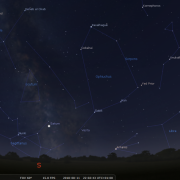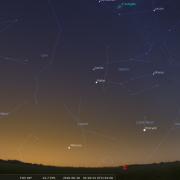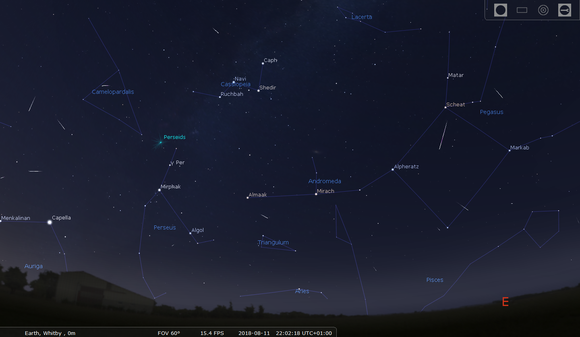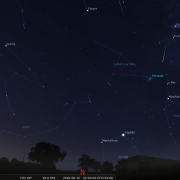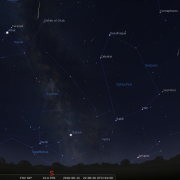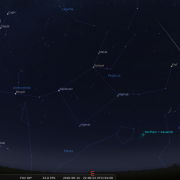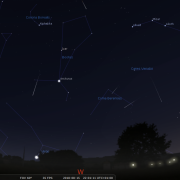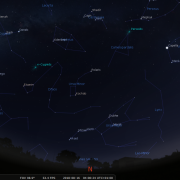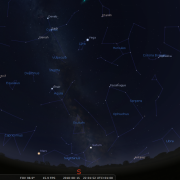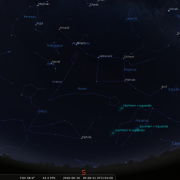In this month's Sky Notes:
Planetary Skylights
 Venus now resides quite low in the west as twilight falls, setting no more than an hour after the Sun. A thin crescent moon lies above on the 14th (20:45h) but you will have to be sharp in spotting Venus as it will drop below the horizon within 20 minutes of this time.
Venus now resides quite low in the west as twilight falls, setting no more than an hour after the Sun. A thin crescent moon lies above on the 14th (20:45h) but you will have to be sharp in spotting Venus as it will drop below the horizon within 20 minutes of this time.

 Jupiter is now edging toward the WSW and is starting to slide down into the brighter evening twilight but remains on view throughout August, setting by 9:30pm at the end of the month. Although dropping lower Jupiter is nevertheless well worth observing, especially early August. Look in particular for the dark banding across the disk and the Galilean moons; the configuration of which alters each night. The Moon lies nearby Jupiter on the 17th.
Jupiter is now edging toward the WSW and is starting to slide down into the brighter evening twilight but remains on view throughout August, setting by 9:30pm at the end of the month. Although dropping lower Jupiter is nevertheless well worth observing, especially early August. Look in particular for the dark banding across the disk and the Galilean moons; the configuration of which alters each night. The Moon lies nearby Jupiter on the 17th.
 Saturn follows Jupiter across the southern aspect, but is also located quite low in the constellation of Sagittarius, just above the ‘teapot’ asterism. Look for a conspicuous pearly white ‘star’ in that direction. A modest telescope will reveal the ring system, which is currently orientated favourably; but due to low altitude patience is required at the eyepiece, waiting for those tantalising steady seeing moments. Look for the major gap in the rings, the Cassini division) and Saturn’s largest moon, Titan, visible as a speck of light close by. Our Moon lies nearby on the 20th and 21st.
Saturn follows Jupiter across the southern aspect, but is also located quite low in the constellation of Sagittarius, just above the ‘teapot’ asterism. Look for a conspicuous pearly white ‘star’ in that direction. A modest telescope will reveal the ring system, which is currently orientated favourably; but due to low altitude patience is required at the eyepiece, waiting for those tantalising steady seeing moments. Look for the major gap in the rings, the Cassini division) and Saturn’s largest moon, Titan, visible as a speck of light close by. Our Moon lies nearby on the 20th and 21st.
 Mars resides low to the SE, and having just reached opposition toward the end of July, it is seemingly still reluctant to show its ‘ruddy’ face before 10pm, especially if you do not have a flat unobstructed eastern aspect. The problem is Mars lies south of the ecliptic, which from the UK is already low during the summer months. Consequently, its fiery presence may be striking to the naked eye, but telescopically Mars all too often appears rather blurry, thanks to our turbulent atmosphere. The Red planet may be just over 35 million miles away, but it still appears smaller in the eyepiece than would be case if it had been the size of Venus. Still, there is the tantalising prospect of viewing the direct surface of another world, so have patience at the eyepiece and you will be rewarded.
Mars resides low to the SE, and having just reached opposition toward the end of July, it is seemingly still reluctant to show its ‘ruddy’ face before 10pm, especially if you do not have a flat unobstructed eastern aspect. The problem is Mars lies south of the ecliptic, which from the UK is already low during the summer months. Consequently, its fiery presence may be striking to the naked eye, but telescopically Mars all too often appears rather blurry, thanks to our turbulent atmosphere. The Red planet may be just over 35 million miles away, but it still appears smaller in the eyepiece than would be case if it had been the size of Venus. Still, there is the tantalising prospect of viewing the direct surface of another world, so have patience at the eyepiece and you will be rewarded.
Look for the polar caps, the dark markings of Mare Cimmerium and Tyrhenum and the fin shape of Syrtis Major.
The Moon lies above Mars on the 23rd.
 Finally, Mercury races into the early morning twilight by mid month, an apparition which lasts into September. Look for it 35–45 minutes before sunrise across in the ENE approximately one binocular field (around 7 degrees) above the horizon. It will be slightly higher and brighter towards the end of the month. If you cannot initially spot it with the naked eye, try with binoculars first.
Finally, Mercury races into the early morning twilight by mid month, an apparition which lasts into September. Look for it 35–45 minutes before sunrise across in the ENE approximately one binocular field (around 7 degrees) above the horizon. It will be slightly higher and brighter towards the end of the month. If you cannot initially spot it with the naked eye, try with binoculars first.
Meteors

One of the highlights on the astro-calendar, the Perseid meteor shower, peaks on August 12th this year and with the moon absent it should be a favourable observing opportunity.
Like the majority of meteor showers, Perseids are a classic example of a cometary debris shower, deposited over many thousands of years. Perseids are associated with comet Swift Tuttle which was discovered in 1862 and takes around 130 years to orbit the Sun. The nature of this meteoroid debris in size and density is not dissimilar to that of instant coffee granules with the occasional pea or marble sized fragment. Every August Earth encounters various strands of the Swift-Tuttle debris stream giving rise to the eagerly anticipated shooting stars.
Perseid meteoroids penetrate the upper atmosphere 60 miles up, reaching speeds of 43miles/second, interacting with atoms in the atmosphere as they do so, before becoming ionised and releasing a packet of light. It is this brief luminous flash we call a meteor. Particularly bright examples often leave behind persistent ionisation trails in their wake, the classic shooting star.
Perseids are so called because their radiant; the location in the sky from which the meteors appear to emanate lies within the constellation of Perseus, which will be rising in the north east during the evening. Perseid activity is highest from Aug 8th-15th reaching a peak this year on Aug 12th, but good rates can be expected during the nights of Aug 10-11 and 12-13, so don't just focus on the night of Aug 11-12 (and risk it being clouded out).
Under ideal conditions the zenith hourly rate (ZHR) for the Perseids is typically around 80. This assumes the radiant is overhead, light pollution is minimal and the observer has all round vision. Obviously then, such rates are rarely witnessed, but with moonlight absent, post midnight viewing should yield upwards of 40 per hour, with late evening viewing of around 15 per hour.
Observing meteors can be frustrating, just like the preverbal bus you can seemingly wait ages for one and then several appear within a few seconds. Have patience, wear warm clothing and perhaps have a warm drink and a snack to hand. Some people watch from a deck chair or lie-low.
Regions of the sky that often seem productive include; the ‘Summer Triangle’ visible high to the south, the Plough; high in the NW, and the Square of Pegasus, rising to the east. Avoid the area of sky Perseus occupies; ie over in the northeast. Shower members appearing close to the radiant have foreshortened tracks; those appearing farther away are often brighter, have longer tracks and move faster across the sky. Fingers crossed for clear skies and have fun.
August 2018 Sky Charts
|
Looking North
Mid-August - 22:00h |
Looking South |
|
Looking East
Mid-August - 22:00h |
Looking West
Mid-August - 22:00h |
|
Northern Aspect
Mid-August - 22:00h |
Southern Aspect
Mid-August - 22:00h |
| Northern Aspect (Early) Mid-August - 04:00h |
Southern Aspect (Early) Mid-August - 04:00h |
Additional Image Credits:
- Planets and Comets where not otherwise mentioned: NASA
- Sky Charts: Stellarium Software
- Log in to post comments

